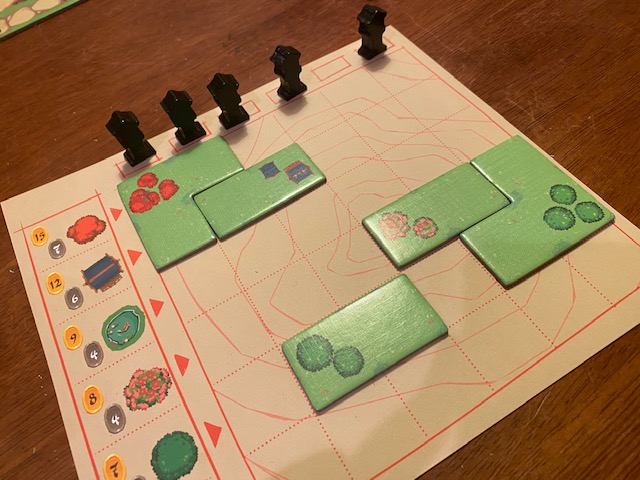Miyabi sees you building tall, Japanese gardens
When it comes to games that have you building upwards or across a large area, the strategy behind stacking tiles and building up is one to be watched across all players. Miyabi is no exception to this, as a two to four player tile placement game with a 45 minute playtime, there is a lot of strategy and watching other players as you build up a simple, yet hilly, garden.
When building your own Japanese garden, you will start with a map in front of you. These maps represent your garden. At the start of the round, a host will put a specific number of different sized tiles in an inventory. You and the other players will then take turns picking one at a time before placing them onto your map.
These tiles have different features on them – rocks, bushes, houses, just to name a few. These features must go in the lane on your map that has these features. This row can be seen on the left hand side of your map. Whichever column across the top that takes the featured tile will also get a statue put into it, as you can only place one tile in each vertical line per round. And, to continue with the concept of planning your garden, you must be placing tiles on flat land — there cannot be overhang of a tile onto nothingness, as that would cause a landslide in your garden.
Placing these tiles is where most of the gameplay comes in, there are so many different options on where to place tiles, despite all of the restrictions. You will need to think strategically to get points which are awarded each time you place a tile. You will get points equal to the number of items on that tile multiplied by the height. Larger tiles have more features on each one, giving you more points. On the flip side, as the board gets full, they are much more challenging to place.
There is a middle board which displays each player’s current score, as well as what round this is. The entire game is over in six rounds, so you can watch your time slowly tick down and see, easily, how far behind or ahead you currently are. There are a few bonuses to keep in mind — displayed by circle tiles that are kept off to the side. These bonuses can be earned if you are the first player to make it to the fifth tile height with various different features, which can make a big difference at the end of the game.
At the end of the game, you can also get more points by having the most features in each row, so when you cover over tiles to build up, you will need to keep in mind the number of features that are currently on your garden and on other people’s gardens — for that tasty, tasty bonus.
With so many different ways to earn points and bonuses up for grabs, a simple garden building game becomes much more challenging in Miyabi. I really love how simple this game is to learn and play, yet how challenging it is to keep track of who is in the lead and who is going to collect a bunch of bonuses at the end of the game.
The base game in Miyabi itself is very simple, but there are five expansions included in the box, which can challenge the core gameplay and continue to make the game more hardcore.
When it came to my time with Miyabi, I found that planning and a bit of luck (hoping others don’t take the tiles you need) are what really keep you in the game. There are so many different ways to continue to make points and build up, but is it always the right choice? Well, that’s down to playing until the end and seeing what everyone’s gardens end up looking like.
You can find Miyabi on HABA’s website.
Love both video games and board games? Here’s our list of some fantastic crossover games.




Comments are closed.